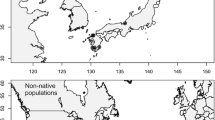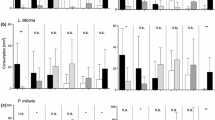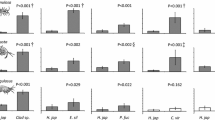Abstract
There is a growing list of marine invertebrate herbivores known to restrict their host choices to a subset of available species, yet the relative importance of the evolutionary forces that select for specialized feeding habits remain unclear. One such specialist is the gammaridean amphipod Peramphithoe tea (F. Ampithoidae) that restricts its distribution to the brown laminarian seaweed Egregia menziesii in Oregon. A field survey indicated that among available seaweeds in the low intertidal zone of Boiler Bay, Oregon, Egregia housed greater than 90% of P. tea individuals. A set of laboratory-based habitat and feeding choice assays revealed that this specialized host distribution is likely the consequence of choices made by adult P. tea. The restricted host choice is apparently maintained by at least two evolutionary forces. First, a juvenile performance assay indicates that both Egregia and the co-occurring seaweed Alaria marginata, provide high food quality relative to other seaweeds available in the low-intertidal zone. Second, a field transplantation experiment revealed that Egregia protects adult amphipods from becoming dislodged with wave energy more readily than did Alaria. Thus, Egregia’s value as good quality food and refuge from abiotic stress together explain the restricted host use of P. tea. A comparison with previous studies suggests that use of Egregia is not consistent across the geographic range of P. tea, suggesting the possibility that the host preferences of local populations may respond evolutionarily to geographic shifts in seaweed communities.




Similar content being viewed by others
References
Bernays E, Chapman R (1994) Host-plant selection by phytophagous insects. Chapman and Hall, New York
Black R (1976) The effects of grazing by the limpet, Acmaea incessa, on the kelp, Egregia laevigata, in the intertidal zone. Ecology 57:267–277
Blanchette CA, Miner BG, Gaines SD (2002) Geographic variability in form, size, and survival of Egregia menziesii around point conception, California. Mar Ecol Prog Ser 239:69–82
Burnaford JL (2004) Habitat modification and refuge from sublethal stress drive a marine plant-herbivore association. Ecology 85:2837–2849
Buschmann AH (1990) Intertidal macroalgae as refuge and food for amphipoda in central Chile. Aquat Bot 36:237–245
Conlan KE, Bousfield EL (1982) The amphipod superfamily Corophioidea in the northeastern Pacific region, family Ampithoidae: systematics and distributional ecology. Publ Biol Oceanogr Natl Mus Can 10:41–75
Cruz-Rivera E, Hay ME (2001) Macroalgal traits and the feeding and fitness of an herbivorous amphipod: the roles of selectivity, mixing, and compensation. Mar Ecol Prog Ser 218:249–266
Cruz-Rivera E, Paul VJ (2006) Feeding by coral reef mesograzers: algae or cyanobacteria? Coral Reefs 25:617–627
D’Antonio C (1985) Epiphytes on the rocky intertidal red alga Rhodomela larix (Turner) C. Agardh: negative effects on the host and food for herbivores? J Exp Mar Biol Ecol 86:197–218
Duffy JE, Hay ME (1991) Food and shelter as determinants of food choice by an herbivorous marine amphipod. Ecology 72:1286–1298
Edgar GJ (1983a) The ecology of south–east Tasmanian phytal animal communities. IV. Factors affecting the distribution of ampithoid amphipods among algae. J Exp Mar Biol Ecol 70:205–225
Edgar GJ (1983b) The ecology of south–east Tasmanian phytal animal communities. I. Spatial organization on a local scale. J Exp Mar Biol Ecol 70:129–157
Edgar GJ (1993) Measurement of the carrying capacity of benthic habitats using a metabolic-rate based index. Oecologia 95:115–121
Fincham AA (1970) Amphipods in the surf plankton. J Mar Biol Ass UK 50:177–198
Friedland MT, Denny MW (1995) Surviving hydrodynamic forces in a wave-swept environment: consequences of morphology in the feather boa kelp, Egregia menziesii (Turner). J Exp Mar Biol Ecol 190:109–133
Gunnill FC (1982) Macroalgae as habitat patch islands for Scutellidium lamellipes (Copepoda: Harpacticoida) and Ampithoe tea (Amphipoda: Gammaridae). Mar Biol 69:103–116
Gunnill FC (1983) Seasonal variations in the invertebrate faunas of Pelvetia fastigiata (Fucaceae): effects of plant size and distribution. Mar Biol 73:115–130
Gunnill FC (1984) Differing distributions of potentially competing amphipods, copepods and gastropods among specimens of the intertidal alga. Mar Biol 82:277–291
Hacker SD, Steneck RS (1990) Habitat architecture and the abundance and body-size-dependent habitat selection of a phytal amphipod. Ecology 71:2269–2285
Hay ME (1992) The role of seaweed chemical defenses in the evolution of feeding specialization and in the mediation of complex interactions. In: Paul V (ed) Ecological roles of marine natural products. Comstock Publishing, Ithaca
Hay ME, Duffy JE, Pfister CA, Fenical W (1987) Chemical defense against different marine herbivores: are amphipods insect equivalents? Ecology 68:1567–1580
Hay ME, Fenical W (1988) Marine plant-herbivore interactions: the ecology of chemical defense. Annu Rev Ecol Syst 19:111–146
Hay ME, Steinberg PD, Fenical W (1992) The chemical ecology of plant-herbivore interactions in marine versus terrestrial communities. Chemical mediation of seaweed-herbivore interactions. Syst Assoc Spec 46:319–337
Holmlund MB, Peterson CH, Hay ME (1990) Does algal morphology affect amphipod susceptibility to fish predation? J Exp Mar Biol Ecol 139:65–84
Jensen KR (1997) Evolution of the Sacoglossa (Mollusca, Opisthobranchia) and the ecological associations with their food plants. Evol Ecol 11:301–335
Kotta J, Torn K, Martin G, Orav-Kotta H, Paalme T (2004) Seasonal variation in invertebrate grazing on Chara connivens and C-tomentosa in Koiguste Bay, NE Baltic Sea. Helgoland Mar Res 58:71–76
Krug P (2001) Bet-hedging dispersal strategy of a specialist marine herbivore: a settlement dimorphism among sibling larvae of Alderia modesta. Mar Ecol Prog Ser 213:177–192
Mackay T, Doyle R (1978) An ecological genetic analysis of the settling behavior of a marine polychaete: I. Probability of settlement and gregarious behavior. Heredity 40:1–12
Moore PG (1978) Turbidity and kelp holdfast Amphipoda: I. Wales and S.W. England. J Exp Mar Biol Ecol 32:53–96
Nelson WG (1979) Experimental studies of selective predation on amphipods: consequences for amphipod distribution and abundance. J Exp Mar Biol Ecol 38:225–245
Nicotri ME (1980) Factors involved in herbivore food preference. J Exp Mar Biol Ecol 42:13–26
Nielsen KJ (2001) Bottom-up and top-down forces in tide pools: test of a food chain model in an intertidal community. Ecol Monogr 71:187–217
Norderhaug KM (2004) Use of red algae as hosts by kelp-associated amphipods. Mar Biol 144:225–230
Poore AB (2004) Spatial associations among algae affect host use in a herbivorous marine amphipod. Oecologia 140:104–112
Poore AGB, Steinberg PD (1999) Preference-performance relationships and effects of host plant choice in an herbivorous marine amphipod. Ecol Monogr 69:443–464
Poore AGB, Steinberg PD (2001) Host-plant adaptation in an herbivorous marine amphipod: genetic potential not realized in field populations. Evolution 55:68–80
Poore AGB, Watson MJ, de Nys R, Lowry JK, Steinberg PD (2000) Patterns of host use among alga- and sponge-associated amphipods. Mar Ecol Prog Ser 208:183–196
Roa R (1992) Design and analysis of multiple-choice feeding-preference experiments. Oecologia 89:509–515
Sotka EE (2005) Local adaptation in host use among marine invertebrates. Ecol Lett 8:448–459
Sotka EE, Hay ME (2002) Geographic variation among herbivore populations in tolerance for a chemically-rich seaweed. Ecology 83:2721–2735
Sotka EE, Hay ME, Thomas JD (1999) Host-plant specialization by a non-herbivorous amphipod: advantages for the amphipod and costs for the seaweed. Oecologia 118:471–482
Sotka EE, Wares JP, Hay ME (2003) Geographic and genetic variation in feeding preference for chemically defended seaweeds. Evolution 57:2262–2276
Steinberg PD, Estes JA, Winter FC (1995) Evolutionary consequences of food-chain length in Kelp Forest communities. Proc Natl Acad Sci USA 92:8145–8148
Steneck RS, Watling L (1982) Feeding capabilities and limitation of herbivorous molluscs: a functional group approach. Mar Biol 68:299–319
Taylor RB, Brown PJ (2006) Herbivory in the gammarid amphipod Aora typica: relationships between consumption rates, performance and abundance across ten seaweed species. Mar Biol 149:455–463
Taylor RB, Steinberg PD (2005) Host use by Australasian seaweed mesograzers in relation to feeding preferences of larger grazers. Ecology 86:2955–2967
Trowbridge CD (1991) Diet specialization limits herbiorous sea slug’s capacity to switch among food species. Ecology 72:1880–1888
Trowbridge CD, Todd CD (2001) Host-plant change in marine specialist herbivores: Ascoglossan sea slugs on introduced macroalgae. Ecol Monogr 71:219–243
Van Alstyne KL, Houser LT (2003) Dimethylsulfide release during macroinvertebrate grazing and its role as an activated chemical defense. Mar Ecol Prog Ser 250:175–181
Van Alstyne KL, McCarthy JJ, Hustead CL, Kearns LJ (1999) Phlorotannin allocation among tissues of northeastern pacific kelps and rockweeds. J Phycol 35:483–492
Viejo RM (1999) Mobile epifauna inhabiting the invasive Sargassum muticum and two local seaweeds in northern Spain. Aquat Bot 64:131–149
Acknowledgments
Thanks to Steve Palumbi, and Bruce Menge, Jane Lubchenco and their laboratory for logistical support. I appreciate the thoughtful comments of two anonymous reviewers. This is Grice Publication Number 300 and was supported in part by Andrew W. Mellon Foundation and the National Science Foundation (OCE-0550245).
Author information
Authors and Affiliations
Corresponding author
Additional information
Communicated by P.W. Sammarco.
Rights and permissions
About this article
Cite this article
Sotka, E.E. Restricted host use by the herbivorous amphipod Peramphithoe tea is motivated by food quality and abiotic refuge. Mar Biol 151, 1831–1838 (2007). https://doi.org/10.1007/s00227-007-0612-5
Received:
Accepted:
Published:
Issue Date:
DOI: https://doi.org/10.1007/s00227-007-0612-5




